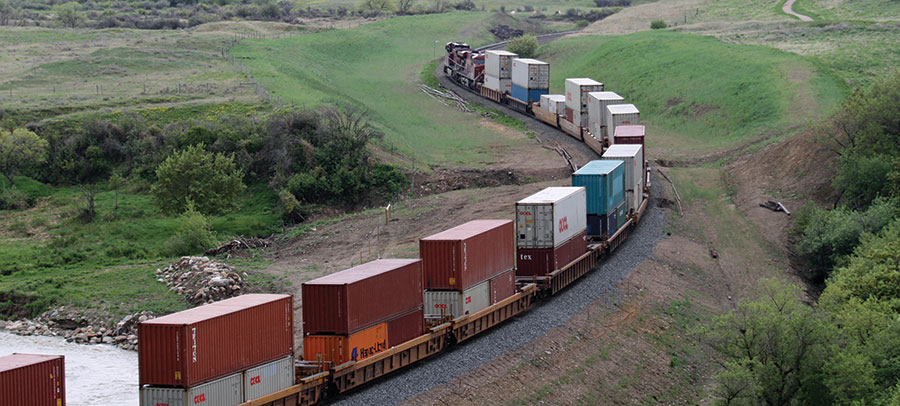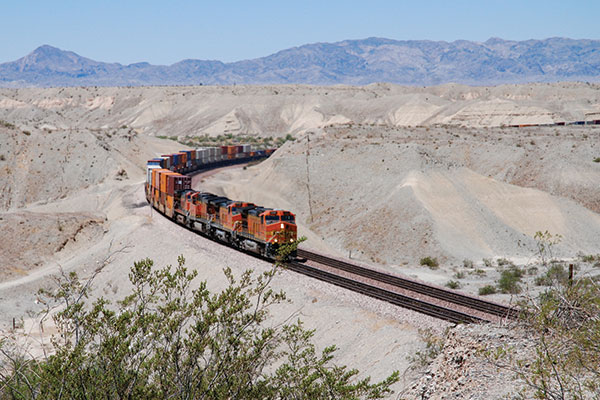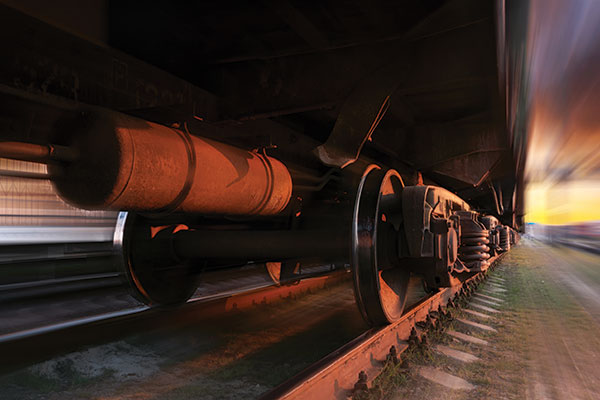11th Annual Rail/Intermodal Roundtable: Looking for signs of normalcy
Four of the nation’s top market analysts examine the current state of the freight railroad and intermodal markets, including the ongoing impact of the pandemic as well as visibility into pricing and service levels over the next year.
A year ago at this time, freight transportation was faced with turmoil on various fronts. One year later, the pandemic remains stubbornly intact, albeit the movement of goods has ostensibly found its footing over the past few months.
However, that doesn’t mean that things are rolling steadily along in the nation’s rail carload and intermodal markets. While annual volumes and GDP comparisons are up, they’re benchmarked against an incredibly uncertain and volatile period from a year ago. What’s more, service levels for both modes are being affected by heavy congestion as well as equipment- and capacity-related challenges.
To help bring the current state of the nation’s rail and intermodal network into clear view for shippers, LM is joined by some of the nation’s foremost experts in the market, including Larry Gross, principal at Gross Transportation Consulting; Tony Hatch, rail analyst and principal at ABH Consulting; Bill Rennicke, partner at management consultancy Oliver Wyman; and Jason Kuehn, vice president at Oliver Wyman.

Logistics Management (LM): How would you define the current state of the rail carload market?
Tony Hatch: Comparisons are skewed, to quote Union Pacific in its Q2/21 earnings call, but demand is pretty strong in merchandise, and even in, for a brief interlude, coal. North American carload volumes were up 15% in June and up 8% for the first half of the year. Tougher comparisons are coming, of course, and grain, a savior in the dog days of the pandemic, will have tough comps and maybe some harvest issues. As, or when, things normalize, this is an area of rail opportunity thanks to IT projects like ‘Rail Pulse.’
Jason Kuehn: Carload traffic is still a bit behind 2019. This lag is indicative of a bit of a sluggish primary manufacturing economy and some residual impacts of prior events such as chemical plants recovering from the deep freeze in Texas as well as the Gulf hurricanes.
Carloads are still recovering demand in the petroleum sector. In the meantime, we’re seeing a continuing decline in coal as a fuel for electric generation as well as the chip and parts shortages hampering automobile production.
LM: With that in mind, how would you summarize the intermodal market from a volume and demand perspective?
Larry Gross: Since the recovery from the pandemic lockdowns began last year, the intermodal sector has struggled to meet demand. The timing and speed of the snap-back took the industry by surprise, and the congestion that resulted from this initial shock has not abated. Continued strong demand has simply not provided the industry with the breathing room to recover. Productivity has suffered from congestion and equipment imbalances and shortages.
Due to the situation, this has limited the volume that the intermodal sector has been able to process. Intermodal revenue moves per month have declined by 12% from March to July, according to IANA data. This is due not to declining demand, but rather operational difficulties, shortages of containers and chassis due to lower equipment velocity and resulting volume constraints. As a result, vessel backlogs are continuing to grow and transit times are suffering.
Hatch: The demand remains strong, and railroads are moving a lot of boxes. IANA reports volumes up 13% through July year-to-date (YTD), but the bad cocktail of driver shortages and congestion has reduced domestic growth to +8.3%—as opposed to +11% June YTD. Interestingly, the Association of American Railroads’ total intermodal data (rails only) is a bit brighter—up 4.1% in August and +8.4% YTD. The demand is there. But, as of now, the fear that consumers would switch to buying experiences, like movies and travel, from “things” that come in boxes has certainly not panned out.
Bill Rennicke: While overall truckload and intermodal demand is strong, intermodal volumes this year are past their pandemic highs, but are below 2019 pre-pandemic levels. International volume is stronger than domestic, while turn-times are elevated in all segments of the intermodal value chain and ports are backed up with ships at anchor.
Extended turn-times have essentially cut the chassis fleet in half—by doubling street time usage in some markets—creating severe congestion at both ports and rail facilities. These same turn-time pressures have created container supply tightness and shortages in key markets.
Warehouses and manufacturing facilities are operating under capacity due to a variety of issues, including labor and materials shortages, as wells as adjusted work protocols due to COVID-19. In the meantime, elevated turn-times have created a severe toll on resources and produce extreme congestion, making operating conditions significantly less productive. All participants in the supply chain are struggling to maintain fluidity in the system—and are using a variety of tactics, including moving to grounded operations or increasing accessorial charges to manage the lack of velocity in the system.
LM: How do you view the current service levels compared to this time a year ago?
Hatch: Ahh…here’s the rub. The rails probably generated a “B+” grade for their 2020 handling of the pandemic seesaw, and that grade deteriorated over the first half of 2021. There have been re-routings, delayed shipments, embargoes, raised demurrage charges, and lots of interest from the Surface Transportation Board (STB), the House T&I Committee, and even from the White House.
Is it the rails’ fault? Some—maybe too much—cost cutting left some short of crews in a time when all jobs are short and when and where, in some cases, government money goes a long way. However, the pandemic was a boulder thrown into a pond—the waves keep breaking, from new outbreaks in Shenzhen to congestion in the docks, poor steamship service, and manpower issues at drayage and shipper nodes.
Kuehn: Given the extreme strain on the asset turn-times, and the resulting congestion in the rail network, it’s inevitable that intermodal service levels are challenged. Frankly, the railroads and the terminals—along with the intermodal operators and chassis providers—have done an outstanding job keeping the system as fluid as possible given the pressures created by the extended turn-times the system is experiencing.
Gross: I’ll cut right to the chase and say that service has deteriorated over the past year and is currently at crisis levels. Vessels are backed up awaiting port space, and once unloaded, the containers are taking much longer to clear the port. According to data filed with the STB, average intermodal train speeds were 1.4 mph slower than a year ago. Unfortunately, the train speed statistics don’t measure the big problem, which is in the intermodal terminals.
This is hinted at by other STB statistics, which show an average of 52 intermodal trains being held for lack of power, crew or other reasons over the four weeks from mid-July to mid-August. A year ago, there were 14. The average number of loaded intermodal cars that have not moved for 48 hours or more was 256 versus 127 a year ago. The lack of adequate quantities of pool chassis has left containers marooned at inland terminals with no way for dray carriers to transport them to final destination.

LM: Considering all of this, what can shippers expect in terms of service over the course of next year?
Rennicke: Returning to high levels of service in the intermodal network requires the system to return to a more normalized velocity and turn times. The backlog of containers that are dwelling either on ships or at terminals or out-the-gate in the shippers’ inventory must be worked down.
While equipment providers are adding equipment, this will not solve the velocity problem—in fact it may make it worse. Ultimately, when the system does return to more normal turn-times, this could create a surplus of equipment in the system. However, the Delta variant and other new virus strains still pose a risk to the recovery.
With disruptions of this magnitude, it’s never clear where the ‘new normal’ will settle and how long it will take for us to get there—but shippers have an important role to play in getting the service back where it should be.
Gross: As congestion rises, productivity drops. As a result, it takes more scarce equipment and manpower just to accomplish the normal volume, much less work down a backlog. The ability to add these assets is being constrained by the same shortages and hiring difficulties that are being seen throughout the economy.
It’s unlikely that service will see much improvement until there’s a break in the demand that provides the industry with some breathing room. I anticipate that this will not occur until the first quarter of 2022. However, I do believe that the current elevated demand levels are not a ‘new normal’ and that demand will revert to something closer to pre-pandemic levels once we get further into 2022.
LM: Is pricing where it needs to be for railroad and intermodal in light of the major capital expenditure
outlays made by the carriers?
Gross: With new records being set for operating ratio by many railroads along with record ocean carrier profits, pricing does not appear to be an overall constraint on investment. For the 50% of intermodal activity that moves in domestic containers and trailers, and is therefore directly truck-competitive, pricing will help determine the attractiveness of the intermodal product offering versus truck. I do expect that truck capacity will be much more available in the coming year and this will produce a more challenging rate environment for intermodal.
Hatch: Pricing is always an area of friction, and all of the carriers in the global supply chain have had to raise rates and have used price to meter the volume and asset flow—and to serve their contractual customers over spot. Inflation may not last, but it’s here and everywhere, so the direction of price is up.
Kuehn: We haven’t seen large capex increases for intermodal in terms of new terminals and additional boxes. Railroads are predictably cautious about how much of the current volume on the system is temporary, and due to turn-time degradations, how much is permanent.
Intermodal pricing is much more a function of truck pricing than anything else. There’s a clear, competitive offering in the form of truck, and intermodal can’t compete when rates rise to the point where truck is the preferred solution. The truck pricing environment is strong and expected to stay strong for at least the next year to 18 months—and rail intermodal pricing will follow.
LM: What is your take on railroad consolidation, given how the CN-KSU deal has been front and center over the last several months?
Rennicke: Historically, there have been clear benefits to rail mergers—as have been seen over the years in terms of railroads’ ability to take out cost and deliver higher asset velocity in general by reducing interchange points. One of the competitive factors facing the rail industry is the lack of ability to create a seamless experience for the customer with any shipment that moves in interline service.
Truckers control the move and the customer relationship end to end. It does not necessarily take a merger to solve this problem. However, the rail industry must agree to work together more closely and create a much more integrated product—both operationally and transparently with information.
Gross: Intermodal is more successful in lanes that can be served by a single railroad versus lanes that involve an interchange. The cross-border trade with Mexico has been an under-performer for this reason because almost all of the volume involves an interchange between railroads.
However, the implications of a merger extend far beyond intermodal, and the STB has signaled that it will take a very close look. One aspect they will be particularly concerned with will be whether the proposed transaction will result in an imbalanced North American network that will trigger further efforts at rail consolidation.
LM: How do you view the emerging presence of technology and automation in freight railroad as they relate to long-term ramifications for the sector?
Kuehn: Technology and automation are advancing nicely in the rail sector, and we have no fear about the future of the industry from a cost perspective. To thrive, the rail industry must find a way to pivot to a growth agenda and better meet customer requirements.
Gross: Lack of resilience and flexibility has been an ongoing problem for the sector. In an era of pandemics, climate change and rising geopolitical tension, the potential for major disruptive events is increasing both in terms of frequency and magnitude. Technology can help to improve the performance of the sector, particularly to the extent that it can better coordinate the actions of the many players involved in making an intermodal move from origin
to destination.
Hatch: Technology and automation are critical. First, their labor, fuel and emissions advantages over trucking are being attacked every day—with electric vehicles and autonomous vehicles (AV). The rails do indeed face an ‘existential threat.’ However, they’re working hard to turn precision railroading (PSR) into that ‘digital backbone’ to automate themselves.
I’ll add that the technology to create autonomous railroading is well ahead of AV. Autonomous railroading could mean not just more efficiency, but also a whole new rail strategy with short, fast e-commerce trains running alongside long PSR-inspired manifest trains.
LM: How will the rail and intermodal markets look five years from now?
Hatch: Five years from now, the rail intermodal markets had better be smoother and more tech-forward, with a digital system integrated with positive train control that allows better visibility and control—and automation to equal or approximate the well-publicized developments we continue to see on the trucking side, including improved labor, fuel and emissions efficiency. That’s the goal. The money and the technological capability is there already, but can railroads avoid distractions and execute?
Gross: I honestly don’t think the intermodal market will look radically different than today. Based on current trends, I expect to see the eventual termination of trailer-on-flat-car services, with only containers being transported, as is already the case in Canada and Mexico. The focus will continue to be on running large point-to-point trains between major population centers. Secondary services and lanes will continue to be de-emphasized.
The current international supply chain difficulties will force shippers to take a fresh look at their overall supply chain strategies. Long-held practices will be changing over time, including ‘just-in-time’ levels of inventory, which will have an additional layer of ‘just-in-case’ safety stock added. Sourcing and routing will be diversified to reduce exposure and increase agility.
While off-shoring will remain, the flow of production and jobs overseas will abate and perhaps a modest reversal will begin. The result will be that international trade volumes will no longer grow faster than domestic and may even lag.
The timing of autonomous trucking continues to move back, but I think it’s likely that we’ll see at least pilot commercial activity within the next five years. This promises to put additional pressure on the intermodal cost/service equation, but autonomy may also offer intermodal with new technologies and approaches that will greatly improve the product offerings.
Rennicke: Disruptions such as the pandemic and climate change cause longer-term changes as they create a field for innovation and a chance to reimagine the future. Just as the economy is at an inflection point with traditional sources of energy and disruptions to the supply chains, so is the rail industry.
The traditional rail bulk commodities comprised of raw materials and petroleum-based fuels and chemicals are in secular decline, and freight growth is concentrated in materials that can also move in a truck.
Five years from now, the intermodal segment will have a much greater share of railroad revenue, and successful railroads will have created innovative new ways to integrate and engage with their customers to better meet their needs and deliver a more customer-centric product that competes effectively with truck

Article Topics
Rail & Intermodal News & Resources
Shipment and expenditure decreases trend down, notes Cass Freight Index Four U.S. railroads file challenges against FRA’s two-person crew mandate, says report U.S. rail carload and intermodal volumes are mixed, for week ending April 6, reports AAR LM Podcast Series: Examining the freight railroad and intermodal markets with Tony Hatch Norfolk Southern announces preliminary $600 million agreement focused on settling East Palestine derailment lawsuit Railway Supply Institute files petition with Surface Transportation Board over looming ‘boxcar cliff’ U.S. March rail carload and intermodal volumes are mixed, reports AAR More Rail & IntermodalLatest in Logistics
Shipment and expenditure decreases trend down, notes Cass Freight Index March trucking tonnage trends down, reports ATA FTR Shippers Conditions Index enters negative territory DAT March Truckload Volume Index sees modest March gains National diesel average, for week of April 22, is down for the second straight week UPS reports first quarter earnings decline LM Podcast Series: Assessing the freight transportation and logistics markets with Tom Nightingale, AFS Logistics More LogisticsAbout the Author
Subscribe to Logistics Management Magazine

Find out what the world's most innovative companies are doing to improve productivity in their plants and distribution centers.
Start your FREE subscription today.
April 2023 Logistics Management

Latest Resources
















